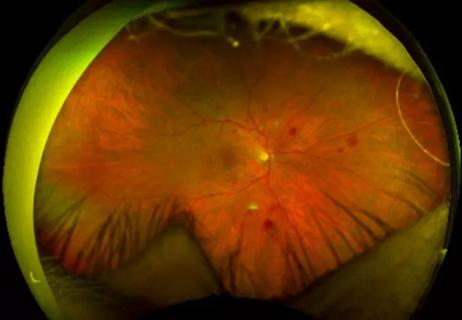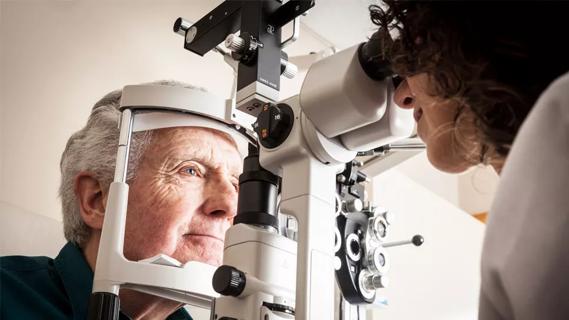CFH gene triggers the eye disease in white patients but not Black patients

Age-related macular degeneration (AMD) is less prevalent and milder in Black populations than in white populations. Now a study published in Nature Genetics has found that the genes associated with AMD in patients with African ancestry are different than those in patients with European ancestry.
Advertisement
Cleveland Clinic is a non-profit academic medical center. Advertising on our site helps support our mission. We do not endorse non-Cleveland Clinic products or services. Policy
Genetic research on AMD has historically focused on white or Asian populations, explains study coauthor Neal Peachey, PhD, of the Department of Ophthalmic Research at Cleveland Clinic Cole Eye Institute. The Nature Genetics study is the first to assess disease across ancestral populations, including people with African or Hispanic heritage.
The study worked with the U.S. Department of Veterans Affairs’ Million Veteran Program, which was launched in 2011 to research health in U.S. veterans recruited at more than 70 Veterans Affairs (VA) medical centers.
“Thanks to this huge number of study participants, we were able to perform the largest genomewide meta-analysis on AMD to date,” says Dr. Peachey, who has dual appointments at Cleveland Clinic and the VA Northeast Ohio Healthcare System. “It’s also the first multi-ancestry AMD study. Ancestry is an important factor that has been overlooked in some genetic studies. We were able to not only address that gap but also demonstrate that ancestry is a critical factor in AMD.”
Highly significant genetic risk factors for AMD were identified as early as 2005. This early research implicated the CFH (and other genes associated with the complement pathway) and ARMS2/HTRA1 genes.
In the recent Million Veteran Program study, researchers studied more than 60,000 veterans with AMD and more than 360,000 veterans without AMD. Key findings included:
Advertisement
“By far, the most important finding was the differing risk profiles among ancestry groups,” Dr. Peachey says. “We now have a lot more research to do to figure out what’s going on. Why are the genes that are so strongly associated with AMD in one group not associated with the disease in another?”
To learn more, Dr. Peachey anticipates two new studies, one using higher-resolution genetic data from the Million Veteran Program.
“These data weren’t available years ago when we started the initial study,” he says. “We plan to dig into these more advanced data and hopefully learn why certain genetic risk factors don’t show up in all populations.”
A second study will explore disease phenotypes in white versus Black patients with AMD.
“We know that AMD is milder in African American patients, but no one has done an extensive study to compare genetic and clinical factors,” Dr. Peachey says. “We have submitted a grant to recruit patients of various ancestries at the Cleveland VA and collect blood samples from which we can extract DNA and do a DNA analysis. In parallel, we will collect optical coherence tomography images and have them analyzed by the lab of Justis Ehlers, MD, at the Cole Eye Institute.”
The future of managing patients with AMD will incorporate genetic risk, predicts Dr. Peachey.
“Based on findings from earlier genetic studies, treatments are being developed for AMD that target the complement signaling pathway,” he says. “But now we know that those treatments are unlikely to be effective in people for whom that pathway isn’t a genetic risk factor. Future treatment trials should consider patients’ genetic risk factors.”
Advertisement
“Big collaborations, like the one in this Million Veteran Program study, are necessary for making advances in genetics, especially when exploring polygenetic diseases,” Dr. Peachey says. “All the major genes now have been identified. When there are multiple genes involved in a disease — and when they vary from one population to another — working together is the only way we can make progress.”
He credits the Million Veteran Program and its rich dataset for helping facilitate these advancements in AMD and says similar work is being done in Cleveland on diseases of the cornea, diabetic retinopathy, glaucoma and dry eye, and across the nation on cancer and diseases of the heart and kidney.
In addition to Dr. Peachey, this research project was led by Sudha Iyengar, PhD, of the VA Northeast Ohio Healthcare System and Case Western Reserve University; Panos Roussos, PhD, of the New York/New Jersey VA Health Care Network and the Icahn School of Medicine at Mount Sinai; and Bryan Gorman, PhD, of the VA Boston Healthcare System and Booz Allen Hamilton.
Advertisement
Advertisement

New insights on effectiveness in patients previously treated with other anti-VEGF drugs

Evidence mounts that these diabetes and obesity drugs may protect eyes, not endanger them

Study identifies factors that may predict vision outcomes in diabetic macular edema

Flaps, blebs and other surgical options

A primer on sustained release options

Study explores association between sleep aid and eye disease

Early data show risk is 73% higher in patients with lupus, 40% higher in patients with rheumatoid arthritis

Switching medications may decrease treatment burden and macular fluid